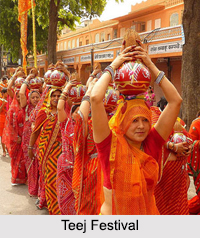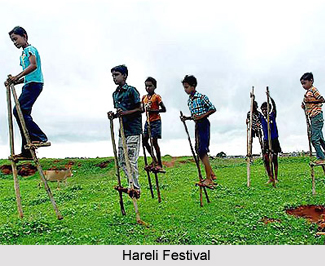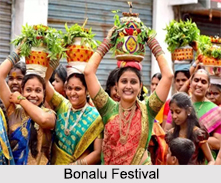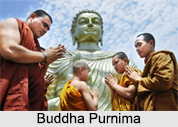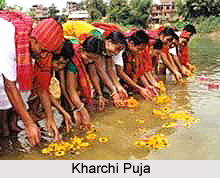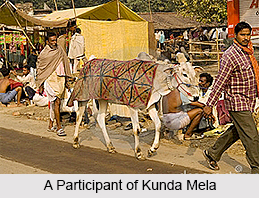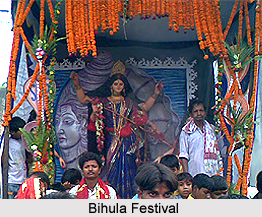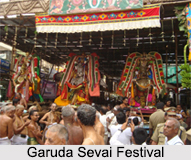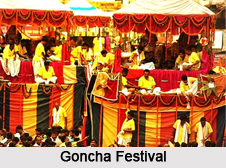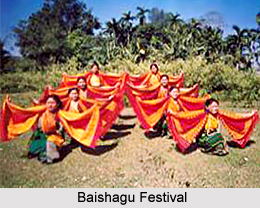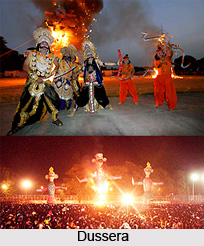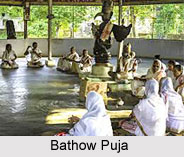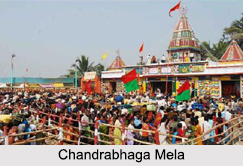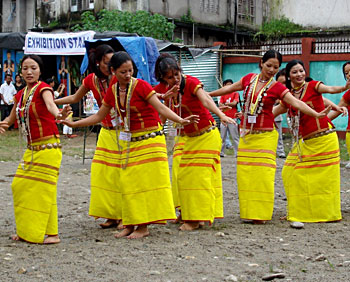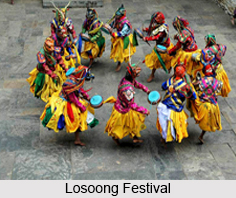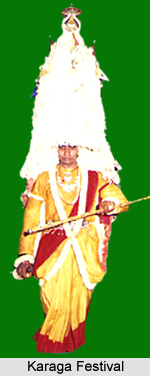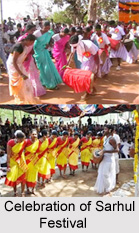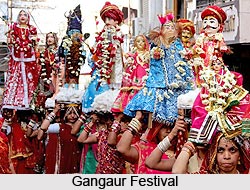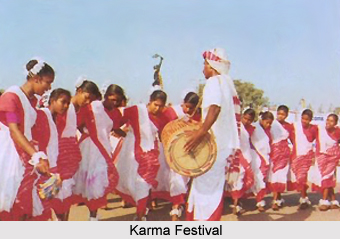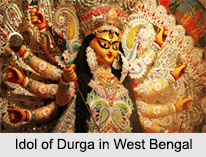 Temple Festivals of Eastern India has diverse historical and cultural surroundings and so there"s a variety of festival festivities in East India. People of eastern India celebrated the temple festivals with religious fervour and the enthusiasm.
Temple Festivals of Eastern India has diverse historical and cultural surroundings and so there"s a variety of festival festivities in East India. People of eastern India celebrated the temple festivals with religious fervour and the enthusiasm.
Some of the well-liked temple festivals of Eastern India States are as follows:
Temple Festivals of West Bengal: The ethnically forward Bengalis, mainly, are the worshippers of Shakti, Goddess Parvati in all her forms. The temple festivals of West Bengal include some of the famous celebrations. Saraswati Puja or Vasant Panchami is celebrated here. Students, teachers and artists worship the Goddess of learning and music and the day is also famous as Vasant Panchami. In the month of October, West Bengal celebrates Durga Puja with great fervour. When the whole country celebrates Navaratri, the last four days are celebrated in West Bengal as Durga Puja. Stunning mud models of the Goddess killing the devil Mahishasura are made and installed in vast pandals. Durga`s four children Ganesh, Kartikeya, Lakshmi and Sarawati are installed next to her. For all the four days, the Goddess is worshipped with all the rituals.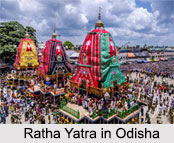 Five days after, on the full moon night comes the Lakshmi Puja. Idols of Lakshmi are installed and worshipped for a day. Offerings mainly of fruits and sweets are made to the Goddess. Within fifteen days of Durga Puja comes Diwali which is celebrated all over India is famous as Kali Puja in West Bengal. Once again, idols of Goddess Kali are made, installed and worshipped. People enjoy eating goodies and burning crackers. Ratha Yatra, though it is famous in Odisha, this festival is a popular temple festival, held in Hooghly district, during the months of June or July at the temples of Mahesh near Serampore. It is a weeklong festival. People throng to have a share in pulling the long ropes attached to the chariots of Lord Jagannath, Balaram and Subhadra on the journey from the temple and back. Jhapan is a festival celebrated in the temples of West Bengal in the district of Bankura. The festival is held in the honour of the serpent-deity Manasa on the last day of the Bengali month Sravana (mid-August).
Five days after, on the full moon night comes the Lakshmi Puja. Idols of Lakshmi are installed and worshipped for a day. Offerings mainly of fruits and sweets are made to the Goddess. Within fifteen days of Durga Puja comes Diwali which is celebrated all over India is famous as Kali Puja in West Bengal. Once again, idols of Goddess Kali are made, installed and worshipped. People enjoy eating goodies and burning crackers. Ratha Yatra, though it is famous in Odisha, this festival is a popular temple festival, held in Hooghly district, during the months of June or July at the temples of Mahesh near Serampore. It is a weeklong festival. People throng to have a share in pulling the long ropes attached to the chariots of Lord Jagannath, Balaram and Subhadra on the journey from the temple and back. Jhapan is a festival celebrated in the temples of West Bengal in the district of Bankura. The festival is held in the honour of the serpent-deity Manasa on the last day of the Bengali month Sravana (mid-August).
Temple Festivals of Odisha: The major and the grandest of all festivals is Ratha Yatra. The best part is the holy journey of the statues of the Lord Jagannath of Puri with brother Balabhadra and sister Subhadra from chief temple to Gundicha Temple, where they stay for nine days. The massive wooden chariots carrying the three deities pulled by thousands of devotees, present an amazing sight. In Odisha, Holi has the name of `Dol Purnima`, but instead of placing the idols of Krishna and Radha on the swing, they put the idol of Lord Jagannath. This is so as of the famous temple of Jagannath at Puri. Moreover, Jagannath is barely an avatar of Krishna. Bali Yatra fiesta in Odisha marks the end of all the religious festivities held in the month of Karthika, which is considered the luckiest month of the 12 months in a calendar year. 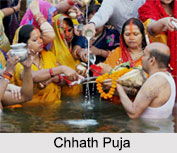 Believed on the full moon day in November/December that is celebrated all over Odisha as Kartika Purnima, Bali Yatra commemorates Odisha`s earliest marine legacy. Maha Shivaratri is celebrated on the 13th night or 14th day on the fading lunar fortnight in the Phalguna month and is regularly falls in February or March. It is considered the night on which Shiva present the Tandava dance. It is observed by fasting by devotee, particularly. Shivaratri is celebrated in key Shaivite temples like Lingaraja temple, Kapilash temple, and Mukteswar temple. Chandan Jatra or Gandhalepana Jatra is a popular Temple Festival of Odisha that is celebrated from Baisakh Shukla Tritiya to Jyestha Shukla Astami. This festival is a cruise in Narendra Pond and carries different reflections of Sri Jagannath, namely Madanmohon, Rama Krishna, Lakshmi, Saraswati and five Shivas. Other Orissa Temple Festivals include "Snana Jatra" on the Jyestha Purnima - the Birth-day of Shri Jagannath. Hera Panchami is observed on the Shukla Panchami, when the image of goddess Lakshmi is ceremonially taken to Gundicha Temple where the chariots are anchored. On the 8th day, the chariots are placed facing south-west for resumption of their return journey next day in the ritual of Dakshinamurti.
Believed on the full moon day in November/December that is celebrated all over Odisha as Kartika Purnima, Bali Yatra commemorates Odisha`s earliest marine legacy. Maha Shivaratri is celebrated on the 13th night or 14th day on the fading lunar fortnight in the Phalguna month and is regularly falls in February or March. It is considered the night on which Shiva present the Tandava dance. It is observed by fasting by devotee, particularly. Shivaratri is celebrated in key Shaivite temples like Lingaraja temple, Kapilash temple, and Mukteswar temple. Chandan Jatra or Gandhalepana Jatra is a popular Temple Festival of Odisha that is celebrated from Baisakh Shukla Tritiya to Jyestha Shukla Astami. This festival is a cruise in Narendra Pond and carries different reflections of Sri Jagannath, namely Madanmohon, Rama Krishna, Lakshmi, Saraswati and five Shivas. Other Orissa Temple Festivals include "Snana Jatra" on the Jyestha Purnima - the Birth-day of Shri Jagannath. Hera Panchami is observed on the Shukla Panchami, when the image of goddess Lakshmi is ceremonially taken to Gundicha Temple where the chariots are anchored. On the 8th day, the chariots are placed facing south-west for resumption of their return journey next day in the ritual of Dakshinamurti.
Temple Festivals of Bihar: Bihar Temple Festivals are enjoyable events celebrated especially in the months of Bhadon and Ashwin. Chhath Puja is one of the primary Bihar Temple Festivals, celebrated with traditional dedication to worship the Sun god. It is celebrated on the sixth day after Diwali, for one night and day. The people of Bihar especially married women; gather to the banks of river Ganga or to other nearby river ghats and ponds to offer a ritual prayer to Sun god for the prosperity, happiness and peaceful life of their family members as well as the long lives of their husbands. Offerings to the Lord include cow`s milk, coconut and other fruits. Some devoted male devotees move slowly in the entire route from their house to the riverbanks as an offering. Devotees observe total fast from sunrise and visit the riverbanks in the afternoon to pay homage. More than one lakh people congregate on the banks of Ganga river where prayers are offered in a tranquil atmosphere. People from other castes also celebrate Chhath Puja with equal importance. Enormous celebrations take place in Bodh Gaya during Buddha Purnima.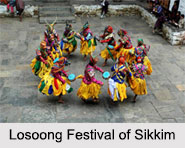 The Buddhists believe that Lord Buddha was born, attained enlightenment and also attained paradise on the same day. Buddhist rituals for celebrating the three-in-one occasion are obviously detailed. Bihar is also the birth place of the 24th tirthankar who preached the Jain religion, Lord Mahavir. Mahavir Jayanti is the most religious event for the Jain community. On this favourable day, splendid chariot parade with the image of Mahavir are taken out, rich ceremonies are held in the temples, fasts and charities are observed, Jain scriptures are read, and at some places majestic fairs are set up.
The Buddhists believe that Lord Buddha was born, attained enlightenment and also attained paradise on the same day. Buddhist rituals for celebrating the three-in-one occasion are obviously detailed. Bihar is also the birth place of the 24th tirthankar who preached the Jain religion, Lord Mahavir. Mahavir Jayanti is the most religious event for the Jain community. On this favourable day, splendid chariot parade with the image of Mahavir are taken out, rich ceremonies are held in the temples, fasts and charities are observed, Jain scriptures are read, and at some places majestic fairs are set up.
Temple Festivals of Sikkim: Majority of the people here is Buddhist, though Hindu population is also there. The Losoong or the Sonam Losar is celebrated as the New Year about February. People rejoice and celebrate their harvest. Youth all over Sikkim have archery competitions and lama dances are held in some of the significant monasteries two days previous to Losoong. These dances figuratively force out the sin spirits of the past year and welcome the good spirits of the coming year. Pang Lhabsol, celebrated in August is an exceptional Sikkim celebration. The people of Sikkim devote and entreat their guardian deity, the mountain of Kangchenjunga. Lamas depict the goddess with fiery-red facemasks with a crown of five skulls, riding a snow lion. Tashiding Bumchu is a different Sikkim festival. The Bumchu is a holy vessel whose water level foretells the luck of the year in advance. It occurs around January - February and continuous for three days when devotees from different parts of Himalayas come for blessings and celebrations at Tashiding monastery.
